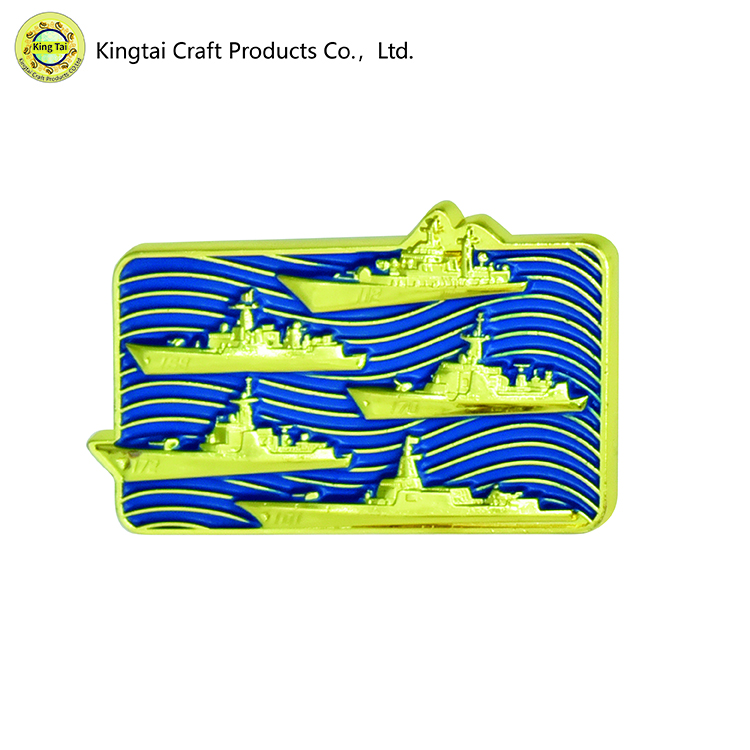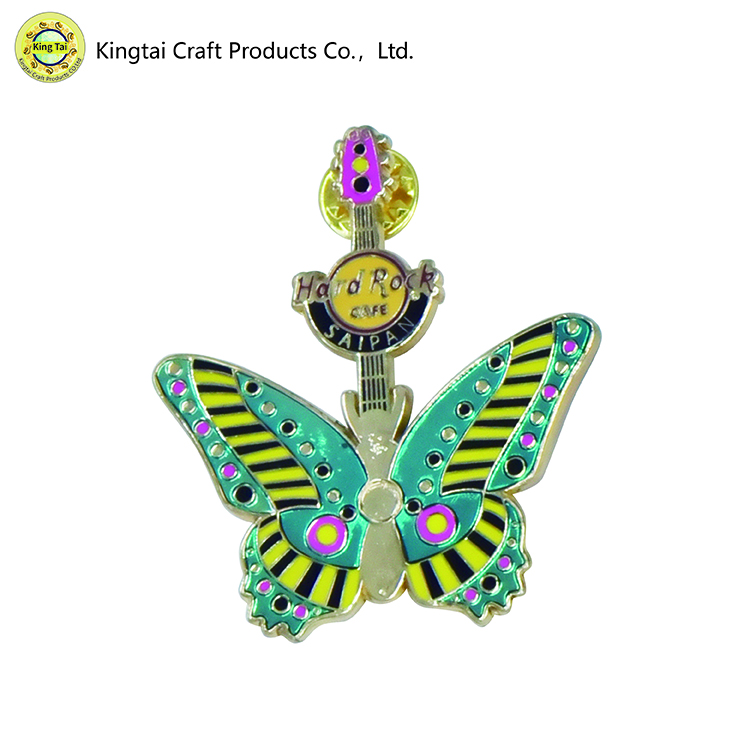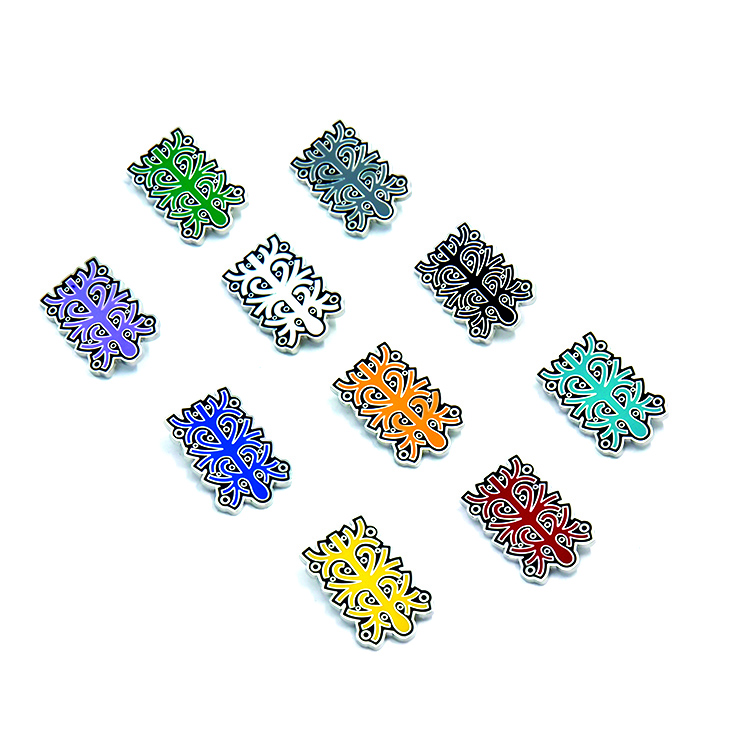The easiest way to tell the difference between soft enamel and hard enamel pins is their appearance.
Soft enamel pins have a rigid, three-dimensional surface that allows you to feel the design when you touch the pin.
In contrast, hard enamel pins have a smooth, two-dimensional appearance. Hard enamel pins don’t have any ridges and are flat and even to the touch.
1. What Are Soft Enamel Pins?
Soft enamel pins are pins with a three-dimensional appearance and textured feel.These pins are created using die-struck metal or stamped metal. This gives the enamel the desired design.
After it’s struck, a thin layer of enamel is poured over the pin. This results in a pin where you can feel the raised edges and grooves of the design.
2. What Are Hard Enamel Pins?
Hard enamel pins are pins with a smooth, even surface.
Like soft enamel pins, they are made using die-struck or stamped metal methods. With hard enamel pins, the enamel is poured into the design until the metal ridges are covered.
After the enamel is poured into the pins, they are polished. This creates their signature smooth two-dimensional appearance.
3. Soft Enamel Pin Advantages and Limitations
Below are the key advantages and disadvantages of using soft enamel pins.
Advantages
● Cheap
● Textured, three dimensional look
● Thinner and lighter than hard enamel pins
● Can use any plating option – metal, dyes, antique finishes, etc.
● Able to capture subtle detail
● Faster to produce
Disadvantages
● Ridges can break or get caught on clothes
● Vulnerable to damage since there is no enamel protective layer
● Not as luxurious as hard enamel
● Can result in more imperfections during the manufacturing process
4. Hard Enamel Pin Advantages and Limitations
Here are the key advantages and disadvantages of using hard enamel pins.
Advantages
● The smooth and sleek finish
● More durable than soft enamel pins
● Often considered higher quality due to price and sleek appearance.
● Fewer impurities in the production process
● Scratch and chip-resistant due to protective coating on top.
● Shiny, bubble-like appearance
Disadvantages
● More expensive
● Takes longer to make due to the final polishing process
● You have limited plating options. You can only use metal finishes, such as gold, silver, or nickel.
● Only work with solid colors – does not allow for overly complicated designs.
5. The Differences Between Hard Enamel and Soft Enamel Pins
● Soft Enamel Pins vs Hard Enamel Pins: Price
Soft enamel pins are cheaper than hard enamel pins. But, the price difference is typically not double or triple.The difference in price will vary depending on the manufacturer. Had enamel pins are typically between 20% and 40% more expensive.
Here at KINGTAI, our hard enamel pins are about 10% more expensive than our soft enamel pins.
A pin’s price will vary on the size, style, design, number of colors, and any other feature you want on the pin. You can find some cheap enamel pins, but it’s likely due to the pin’s other characteristics.When all things are held equal soft enamel pins are cheaper than hard enamel pins.
Hard enamel pins are more expensive because it’s more time consuming and requires extra steps.
First, the painting process is more time consuming and intricate than soft enamel pins.
Second, the additional polishing stage is more labor-intensive.
● Soft Enamel Pins vs Hard Enamel Pins: Detail
Soft enamel pins take the win here as well. Soft enamel pins are capable of displaying more detail than hard enamel pins.
One reason for this is that the ridges and grooves of soft enamel pins are exposed and lifted. This makes it easier to see and identify the details.
Hard enamel pins are filled to the top with enamel and then polished. The polishing phase can round out the ridges of the design and make the details harder to identify.
Due to the raised ridges, soft enamel pins have a three-dimensional look. The texture and ridges make it appear like the pins have more detail.
Hard enamel pins are filled and appear two dimensional, and this creates a less detailed pin.
● Soft Enamel Pins vs Hard Enamel Pins: Durability
Hard enamel pins are more durable than soft enamel pins.
This is because hard enamel pins have a protective coating. This finish acts as a protective coating. This helps prevent scratching or chipping of the paint or any raised metal ridges.
Soft enamel pins have exposed metal ridges. These ridges do give it it’s three-dimensional appearance, but they also make it more vulnerable. The exposed metal makes it more likely to scratch or chip.
For example, if you were to drop a soft enamel pin on the floor, the concrete would hit the pin’s paint and ridges.
With hard enamel pins, the paint and metal outline would never come in touch with the concrete.
Some manufacturers offer epoxy protective coating over soft enamel pins. This can make soft enamel pins more durable. But, it also takes away their signature rigid, three-dimensional feel.
● Soft Enamel Pins vs Hard Enamel Pins: Texture
Once again, soft enamel pins take the victory here. Soft enamel pins have more texture than hard enamel pins.
Soft enamel pins have a rigid surface that allows you to feel every look and cranny of the design. This texture is what gives soft enamel pins their signature look.
Hard enamel pins are soft and smooth. You can not feel any ridges or design features on a hard enamel pin. Hard enamel pins are filled to the top and then polished to create a sleek, rounded appearance.
If you prefer textured, three-dimensional pins, then soft enamel pins are the best option. If you are looking for a more slick and subtle look, you might prefer a hard enamel pin.
● Soft Enamel Pins vs Hard Enamel Pins: Elegance
Elegance and beauty are subjective. Nonetheless, hard enamel pins are often considered more elegant than soft enamel pins.
The smooth, sleek finish of hard enamel pins gives off a high-quality appearance.
Soft enamel pins are more popular and less expensive. This adds to hard enamel pins’ elusiveness. Since they are more expensive and less common, they are often perceived as classy and elegant.
● Soft Enamel Pins vs Hard Enamel Pins: Size
This match is a draw. When it comes to size, soft enamel and hard enamel pins have no distinct difference.
The difference in size you will find will be between manufacturers. Certain manufacturers may produce larger or smaller pins than other manufacturers.
Also, the level of detail can impact the size of the pin. In particular, pins with intricate details need to be larger.This is because, at smaller sizes, the details get lost within the pin.
Overall both hard enamel and soft enamel pins can range from ½ an inch to 2 inches in size. Depending on the manufacturer, you might be able to get more.
● Soft Enamel Pins vs Hard Enamel Pins: Finish/Surface
The finish or surface of a pin is also called plating. Hard enamel pins have fewer plating options than soft enamel pins.
With soft enamel pins, you can use any color or material for the plating process. This can range from gold, painted black, or an antique finish.
Hard enamel pins have fewer options. With hard enamel pins, you can typically only use metal platings such as nickel, bronze, or gold.
If you want your plating or the ridges of your design to be black, the limitations become evident.
With soft enamel pins, you can easily choose to have your plating painted black. With hard enamel plating, you can not use black paint. The only option is to use black nickel.
The problem with black nickel is that it’s not really black. Black nickel is a dark grey with a shiny finish.
● Soft Enamel Pins vs Hard Enamel Pins: Manufacturing Process
The process for soft enamel pins and hard enamel pins are relatively the same at the beginning.The hard enamel and soft enamel manufacturing process only differ after the dies have been cut and polished.
The pins will experience the same steps, but the technique and order of those steps vary.Soft enamel pins are first electroplated. Then they are painted. Unlike, hard enamel pins they are not polished at the end.
With hard enamel pins, the colors are first added in a meticulous layer by layer application. After the colors, they are electroplated and finally polished for a smooth finish.
● Step by Step Breakdown
1.Creating the Mold For The Pin
The initial process begins with creating the metal for the base of the pin. This is done either using the die-struck or metal stamp process. These methods are used to create the shape and size of the pin.
2.Cutting the Design
Once the metal base is created, the design is cut out of the metal.
3. Polishing
Once the design is cut, the metal is polished to give it a smooth finish.
After the design is cut and polished, the soft enamel and hard enamel pins follow a different process.
● Soft Enamel Pins
4. Protection: Electroplating or Spraying
Depending on the manufacturer, these steps may vary, but the purpose is the same. The step adds a protective layer to the metal to make it more durable.
5. Adding Colors
After the pins are cut, and coated layers of color are added to the design.
With soft enamel pins, only a thin layer of color is applied to keep the metal ridges of the design exposed.
6. Baking
Once the colors are applied, the pin is placed in an oven to help the colors set.
7. Quality Control and Packaging
Once the pins are removed from the oven, they are inspected for impurities and packaged.
● Hard Enamel Pins
4. Adding Color
On hard enamel pins, after the pin is cut, the colors are added to the design. Each layer of color needs to be added individually and dried before a new color can be applied.
Hard enamel pins receive multiple layers of color until it is flush with the
5. Baking
After the colors are applied, the pin is baked to let the colors set. Hard enamel pins are baked separately for each color that is applied.
6. Protection: Electroplating or Spraying
A protective layer is applied at the end of the manufacturing process to hard enamel pins. Whereas soft enamel pins receive protection before the colors are applied.
7. Polishing
To finish the pin, the pin is polished and ground to give it a smooth finish.
8. Quality Control and Packaging
Once the pins are polished, they are packaged and ready for shipment.
6. When should you buy soft enamel pins?
Soft enamel pins are more popular and easy to find compared to hard enamel pins.Soft enamel pins are ideal if you are on a budget but still looking for a high-quality head-turning pin.
You should also opt for soft enamel pins if you are looking for an intricate design with more colors.
If you want your pin to pop with texture and detail, then soft enamel pins are the best option. You’ll be able to feel every detail of your pin, and you don’t even have to look at it.
7. When Should you buy hard enamel pins?
One of the biggest advantages that hard enamel pins offer is their durability. These pins are built to last without any damage.
If you expect you will constantly expose and use your pin, then you might want to opt for hard enamel pins.Hard enamel pins are scratch-resistant. Since there are no ridges, they are less likely to break or chip.
You should also choose hard enamel pins if you want a more classy and sleek design to your pins. The smooth, detailed finish is often regarded as high-quality and desirable.
Post time: Aug-21-2022




